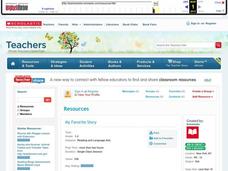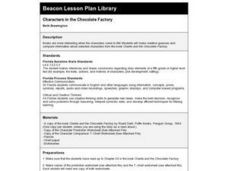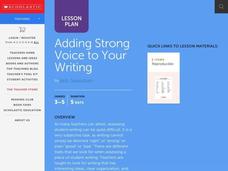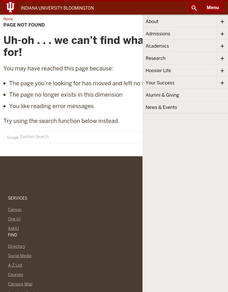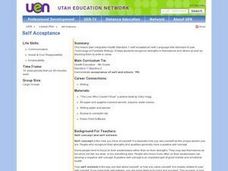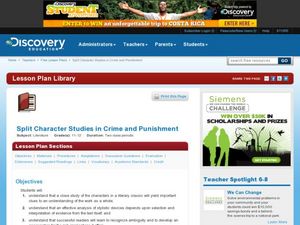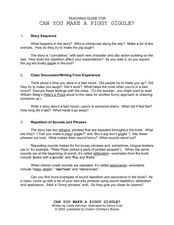Curated OER
Good Day/Bad Day
Students read the book Alexander and the Terrible, Horrible, No Good, Very Bad Day and discuss a bad day that they have had. In this bad day lesson plan, students compare their bad day with the story.
Curated OER
Who's Afraid of the Big, Bad Wolf?
Students, at the advanced beginner to low intermediate ESL levels, demonstrate comprehension of the play or story, "Little Red Riding Hood." They construct interviews based on knowledge of the characters in the play Little Red Riding Hood.
Curated OER
My Favorite Story
Learners discuss their favorite book. In this book discussion instructional activity, students name the title and tell what makes the book special. Learners also review the setting, plot, conflict, and resolution. Students make a book...
Student Achievement Partners
Eleven
Turning 11 comes with a range of emotions. Explore those emotions by reading the short story "Eleven" by Sandra Cisneros. Readers analyze the main character's reactions to the events of her day. Then, they write an essay describing what...
Curated OER
Through the Eyes of the Big Bad Wolf
Imagine how the wolf would tell the tale of Little Red Riding Hood or The Three Little Pigs. Young writers re-imagine classic tales by adopting the point of view of another character in the story. After reading models like The True Story...
Curated OER
Characters in the Chocolate Factory
Students dress and act as selected characters from Roald Dahl's "Charlie and the Chocolate Factory". They identify each other and make predictions about the upcoming chapters based on their observations about the characters.
Curated OER
Adding Strong Voice to Your Writing
Identify examples of strong voice in popular picture books. Young authors add voice to their writing and revise their own writing. In addition, they share their writing with their peers.
Curated OER
"Split" Character Studies in Crime and Punishment
Students write an essay evaluating split character traits on major characters in Dostoevsky's novel Crime and Punishment. In this instructional activity students are guided through discussion questions, group assignments, and vocabulary...
Curated OER
Harmony and Expression in Writing Form
How do you write an interesting beginning, middle, and end of a story? With this lesson, young writers look to other stories as examples. Then, they use some of the attached graphic organizers to help them create their own story. Note:...
Curated OER
Good Prevails
Students write descriptive paragraphs of characters after reading a Japanese folktale in which characters represent by good and evil.
Curated OER
December
Students create snowflake similes, Kwanzaa plaques, menorah banners, and more for the month of December. For this December activities lesson plan, students also analyze characters in How the Grinch Stole Christmas.
Curated OER
Character Cluster
Third graders practice identifying characters and story elements by creating a character cluster in class. In this story analysis lesson plan, 3rd graders discuss the story Snow White and identify the characteristics of the evil...
Overcoming Obstacles
Becoming a Good Friend
A lesson puts a spotlight on becoming a good friend. After pointing out TV friendships, scholars listen to several scenarios and discuss whether the characters exhibit good or bad friendly behaviors. Learners reflect on the...
Curated OER
My Writing Portfolio
Emerging writers create a portfolio showcasing various writing formats. They discuss Alexander and the Terrible, Horrible, No Good, Very Bad Day. They observe the key features of picture books and then create their own book to add...
Curated OER
Mr. Peabody's Apples
Students read Mr. Peabody's Apples. In this reading lesson, students complete pre-and post-reading activities to improve comprehension skills. Students role play scenes from the story to analyze.
Curated OER
Heaven or Ground Hog Day?
Students discover the ideas of enlightenment by reading historical poetry. In this philosophical lesson, students read poems by Sir Walter Scott and Sergeant Joyce Kilmer while discussing the themes of the writing with classmates....
Curated OER
Self-acceptance
Students assess the importance of acceptance of self and others via the development of self-worth and the looking for the good in others not the bad. They explore the task of looking at the world through the eyes of others. In addition,...
Curated OER
The Only Boy in the Ballet Class
Young scholars discuss kindness and how to treat others. In this kindness lesson plan, students listen to the story The Only Boy in the Ballet Class by Denise Gruska. The teacher draws the main character and every time that he receives a...
Curated OER
Lessons of the Indian Epics: The Ramayana
Students read a version of Ramayana and explore the elements of the epic hero cycle. In this Ramayana analysis lesson, students retell the basic narrative of the Ramayana and identify the main characters. Students identify elements of...
Curated OER
Split Character Studies in Crime and Punishment
Students identify characters who exhibit conflicting character traits. In this Crime and Punishment lesson, students identify and discuss characters who have opposing character traits. Students relate their character study to...
Curated OER
Enemy Pie
Students complete activities with the book Enemy Pie by Derek Munson. In this literature lesson plan, students answer questions before and during the reading. They describe how the main character's feelings changed.
Curated OER
We Need More Than Money
Young scholars identify examples of private resources. In this philanthropy lesson, students read the book A Chair for My Mother and identify the private resources the characters used in the text. Young scholars name private resources...
Curated OER
Sticks and Stones
Students explore bullying. In this character development lesson, students discuss verbal and nonverbal bullying. Using the "sticks and stones" adage, students write a sentence describing a hurtful act on a gray piece of paper,...
Curated OER
Teaching Guide: Can You Make a Piggy Giggle?
Learners explore the book Can You Make a Piggy Giggle?. In this language arts lesson, students focus on a variety of aspects within the book. Learners study the illustrations, listen for rhymes, and attempt the tongue twisters in the text.


